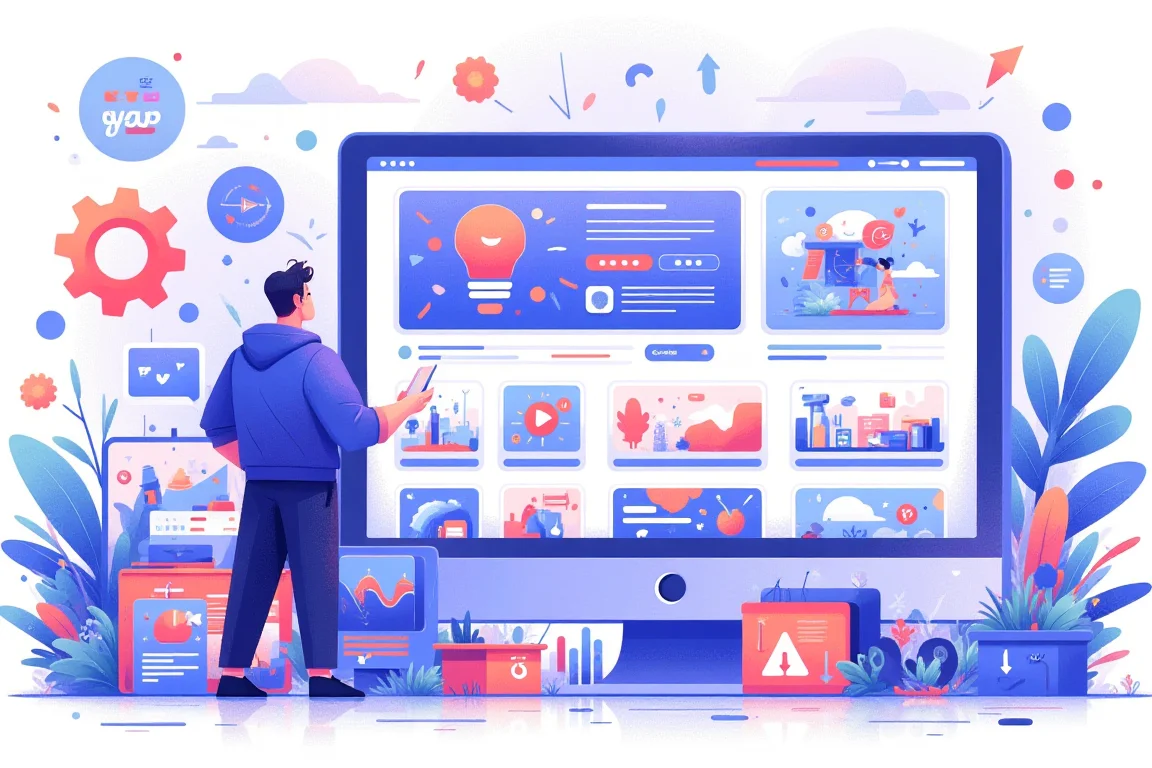Stop overthinking which digital product to create first. The most successful digital products for beginners aren’t mysterious unicorns—they’re practical solutions to real problems that people willingly pay to solve. Instead of reinventing the wheel, you can start with products that have already proven their worth in the marketplace.
Key Takeaways
The most successful digital products for beginners include ebooks and guides (particularly in health, business, and personal development niches), digital templates and planners (budget trackers, printable calendars, and productivity tools), online courses and tutorials (skill-based learning in popular areas), and ready-made business resources like pitch deck templates and social media content.
Quick wins for beginners:
- Printable planners and organizers – High demand, low competition in specific niches
- Business templates – Pitch decks, business plans, and branding kits for entrepreneurs
- Educational ebooks – How-to guides in trending topics like personal finance and wellness
- Canva templates – Social media posts, presentations, and marketing materials
- PLR products – Pre-made digital products you can rebrand and sell immediately
These products work because they solve immediate problems, require minimal technical skills to create or customize, and can be sold repeatedly without additional production costs. The key is choosing products that match your expertise while targeting audiences with proven buying behavior.
Ready to skip the creation phase entirely? PLR Digital Products on plrbizhub.com offers hundreds of professionally created digital products you can rebrand and start selling immediately. These done-for-you solutions include ebooks, courses, templates, and planners across profitable niches—saving you months of creation time while providing proven products that customers already want to buy.
Understanding Digital Product Success
What Makes Digital Products Successful
The most successful digital products share specific characteristics that separate them from the thousands of products that never gain traction. Problem-solving focus stands as the primary driver—successful products address real pain points that customers actively seek solutions for. Whether it’s a budget tracking template that helps people manage finances or a business plan template that guides entrepreneurs through startup planning, effective products solve immediate, tangible problems.
Market demand verification represents another crucial factor. The most successful digital products target audiences who already demonstrate buying behavior in their respective niches. Health and wellness products, business resources, and educational materials consistently rank among top sellers because these markets contain motivated buyers willing to invest in solutions.
Ease of consumption also plays a vital role. Products that customers can immediately use—like printable planners, ready-to-edit templates, or step-by-step guides—outperform complex offerings that require significant time investment to understand or implement.
Digital Product Categories That Generate Revenue
Educational content dominates the digital product landscape, with ebooks and online courses leading revenue generation. These products work particularly well because they position sellers as experts while providing genuine value to customers. Topics like personal finance, health improvement, and business development consistently attract buyers across all age groups.
Template-based products represent another high-performing category. Business templates, social media graphics, and productivity planners appeal to time-conscious customers who prefer ready-made solutions over starting from scratch. These products often command higher prices relative to their creation costs because they save customers significant time and effort.
PLR (Private Label Rights) products offer a unique opportunity for beginners to enter the digital product market without creating original content. These pre-made products come with licensing that allows buyers to rebrand and resell them as their own, effectively providing a shortcut to product ownership.
Useful Articles:
Top Digital Product Categories for Beginners
Ebooks and Digital Guides
Ebooks remain among the most accessible entry points for digital product beginners. Health and wellness guides consistently perform well, particularly those addressing specific conditions or lifestyle changes like keto diets, natural healing approaches, or fitness routines. The key lies in targeting specific problems rather than broad topics—”30-Day Sugar Detox Guide” outperforms “Healthy Living Tips” every time.
Business and entrepreneurship guides represent another profitable niche. Topics like “Starting an Amazon Business,” “Freelancing Success Strategies,” or “Social Media Marketing for Small Businesses” attract motivated buyers willing to invest in their professional development. These products often command higher prices because they promise direct financial returns.
The creation process for ebooks has become increasingly streamlined with tools like Google Docs, Canva, and even AI writing assistants. However, successful ebooks require more than just information compilation—they need clear structure, actionable advice, and professional presentation to compete effectively.
Digital Templates and Planners
Productivity planners have exploded in popularity as people seek better organization systems. Budget trackers, meal planners, fitness journals, and daily productivity sheets consistently rank among best-selling digital products. These items work because they combine immediate utility with ongoing value—customers return to use them repeatedly.
Business templates serve entrepreneurs and professionals who need quick solutions for common tasks. Pitch deck templates, business plan outlines, social media content calendars, and email marketing sequences save customers hours of work while providing professional-quality results. The demand for these products continues growing as more people start online businesses.
The beauty of template-based products lies in their scalability. Once created, they can be sold infinitely without additional production costs. Tools like Canva, Adobe Creative Suite, and even PowerPoint provide sufficient capabilities for creating professional-quality templates.
Online Courses and Tutorials
Skill-based learning drives significant revenue in the digital product space. Courses teaching practical skills like graphic design, social media marketing, WordPress development, or photography attract students willing to pay premium prices for structured learning experiences. The key is focusing on skills with clear professional applications rather than general interest topics.
Niche expertise courses often outperform broad educational content. Teaching specialized skills like “Creating Viral TikTok Content” or “Building Shopify Stores for Local Businesses” targets motivated audiences with specific goals. These courses can command higher prices because they address focused needs with measurable outcomes.
Course creation has become more accessible through platforms like Teachable, Thinkific, and even simple video recording tools. The most successful courses combine video instruction with downloadable resources, creating comprehensive learning experiences that justify higher price points.
Ready-Made Business Resources
Marketing materials consistently attract business owners and marketers seeking professional-quality content without design costs. Social media post templates, email newsletter designs, and presentation templates serve busy professionals who value time-saving solutions. These products often generate recurring customers who return for additional materials.
Industry-specific resources command premium prices by addressing specialized needs. Real estate marketing templates, restaurant menu designs, or fitness studio promotional materials target specific business types with tailored solutions. The narrower the focus, the higher the perceived value and pricing potential.
PLR Products as a Fast-Track Solution
Understanding PLR Products
PLR (Private Label Rights) products offer beginners an immediate entry into digital product sales without the time investment of content creation. These pre-made products come with licensing that allows buyers to rebrand, modify, and sell them as their own work. The concept eliminates the biggest barrier for new digital entrepreneurs—not knowing what to create or how to create it.
Quality PLR products include ebooks, courses, templates, software, and multimedia content across virtually every profitable niche. Unlike free content or basic resale rights, PLR products grant full modification rights, allowing sellers to customize content, add their branding, and even combine multiple products into new offerings.
The PLR marketplace has evolved significantly, with professional providers now offering high-quality content created by native English writers and professional designers. This evolution addresses earlier concerns about PLR quality, making these products viable alternatives to custom content creation.
Benefits of Starting with PLR
Immediate market entry represents the primary advantage of PLR products. Instead of spending months creating content, researching topics, and developing products, beginners can launch their digital business within days. This speed advantage allows for faster testing of markets and niches without significant upfront investment.
Proven market demand characterizes quality PLR products. Reputable providers create content based on market research and trending topics, ensuring their products address real customer needs. This market validation reduces the risk of creating products that no one wants to buy.
Cost efficiency makes PLR particularly attractive for beginners. High-quality PLR products typically cost between $7-$97, significantly less than hiring content creators or investing hundreds of hours in original content development. This low barrier to entry allows beginners to test multiple niches without major financial risk.
Selecting Quality PLR Products
Source reputation determines PLR product quality more than any other factor. Established providers like PLR.me, IDPLR, and specialized niche suppliers consistently deliver professional-quality content with proper licensing. These platforms often provide sample content, customer reviews, and detailed product descriptions to help buyers make informed decisions.
Content freshness impacts sales potential significantly. Recent PLR products addressing current trends and challenges typically outperform older content, even if the older content covers evergreen topics. Regular updates and new product releases indicate active, responsive PLR providers who understand market dynamics.
Licensing clarity protects both sellers and buyers. Quality PLR products include clear licensing terms specifying modification rights, resale permissions, and any restrictions. Understanding these terms prevents legal issues and ensures proper product usage across different selling platforms.
Useful Articles:
Platform Options for Selling Digital Products
Marketplace Platforms
Etsy dominates the market for creative digital products, particularly printables, templates, and artistic content. The platform’s built-in audience of buyers seeking handmade and creative products makes it ideal for certain types of digital offerings. However, Etsy’s fees and competition require strategic product positioning and strong SEO optimization to achieve visibility.
Gumroad provides a streamlined solution for independent digital product sellers. The platform handles payment processing, file delivery, and customer support while maintaining seller control over pricing and product presentation. Its simplicity makes it particularly attractive for beginners who want to focus on product creation rather than technical setup.
Creative Market caters specifically to design-focused digital products like fonts, graphics, and templates. While the platform maintains higher quality standards and charges significant fees, approved sellers benefit from exposure to a professional design audience willing to pay premium prices.
Self-Hosted Solutions
Shopify offers comprehensive ecommerce functionality specifically designed for digital products. The platform provides professional storefronts, integrated payment processing, and numerous apps for digital product delivery. While monthly fees and transaction costs add up, Shopify’s features and reliability justify the investment for serious sellers.
WooCommerce appeals to technically inclined sellers who want complete control over their online stores. As a WordPress plugin, it provides unlimited customization options and lower ongoing costs compared to hosted solutions. However, successful WooCommerce stores require technical knowledge and ongoing maintenance.
Thinkific specializes in course creation and delivery, offering tools for building comprehensive educational products. The platform includes features like student progress tracking, quiz creation, and certificate generation that enhance the learning experience. While focused primarily on courses, Thinkific can handle various digital product types.
Social Media Integration
Instagram and TikTok have emerged as powerful sales channels for certain digital products. Visual products like templates, planners, and design resources perform particularly well on these platforms. Success requires consistent content creation and strategic hashtag usage to reach potential customers organically.
Pinterest drives significant traffic to digital product sellers, especially in niches like home organization, health, and business productivity. The platform’s search-friendly format makes it ideal for promoting printables and templates. Successful Pinterest marketing requires understanding the platform’s SEO principles and visual content standards.
Facebook groups and communities provide targeted audiences for specific digital products. Joining relevant groups and providing value before promoting products helps build relationships and trust with potential customers. This approach works particularly well for business-focused products and educational content.
Pricing Strategies That Work
Value-Based Pricing Models
Problem severity pricing aligns product costs with the intensity of problems they solve. Business templates that help entrepreneurs secure funding command higher prices than general productivity planners because the potential return justifies the investment. Understanding customer pain points and potential outcomes enables strategic pricing decisions.
Time-saving calculations provide another pricing framework. If a template saves customers 10 hours of work at a $50 hourly rate, pricing it at $99 becomes justifiable value. This approach works particularly well for business-focused products where time has clear monetary value.
Expertise positioning allows knowledge-based products to command premium prices. Courses and guides created by recognized experts in their fields can charge significantly more than similar content from unknown creators. Building credibility through content marketing and social proof supports higher pricing strategies.
Competitive Analysis Approaches
Market research reveals pricing opportunities within specific niches. Analyzing competitor prices, product features, and customer reviews identifies gaps where new products can position themselves effectively. This research prevents both underpricing and pricing beyond market acceptance levels.
Feature differentiation justifies price variations among similar products. Adding bonus materials, exclusive access, or enhanced support creates value that supports higher pricing. Successful differentiation focuses on benefits customers specifically request or mention in competitor reviews.
Bundle strategies increase average transaction values while providing customer value. Combining related products—like a budget template with expense tracking sheets and financial planning guides—creates compelling packages that command higher prices than individual items.
Testing and Optimization
A/B testing different price points reveals optimal pricing for specific audiences and products. Starting with higher prices and adjusting downward based on conversion rates often produces better results than starting low and attempting to raise prices later. Digital products make price testing particularly easy since there are no inventory costs.
Seasonal adjustments capitalize on buying pattern changes throughout the year. Business planning templates sell better in January, fitness products peak in January and summer months, and educational content often performs well before school seasons. Understanding these patterns enables strategic pricing and promotional timing.
Customer feedback integration guides pricing decisions based on perceived value rather than just market comparison. Direct customer surveys, review analysis, and sales conversation insights reveal whether prices align with customer value perceptions. This feedback loop ensures pricing remains competitive while maximizing revenue potential.
The most successful digital products combine proven market demand with strategic positioning and competitive pricing. Starting with established product categories and gradually developing unique offerings provides the best balance of risk management and profit potential for beginning digital entrepreneurs.




